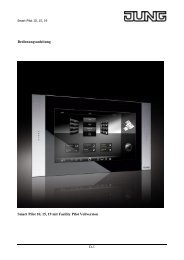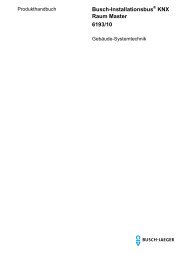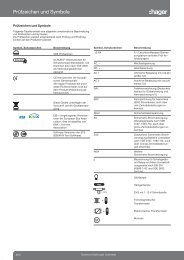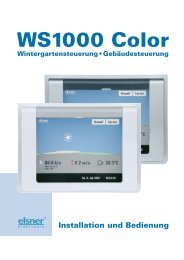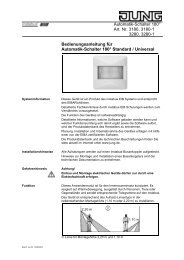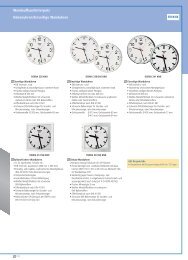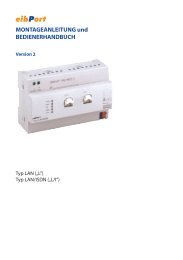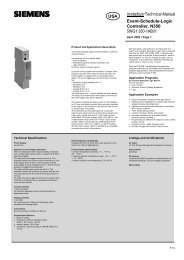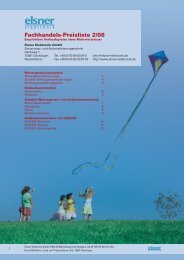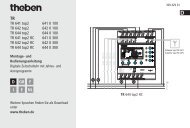You also want an ePaper? Increase the reach of your titles
YUMPU automatically turns print PDFs into web optimized ePapers that Google loves.
4.3 PC Client software<br />
4.3.1 Introduction, installation and program start<br />
Installing the PC Client software<br />
The PC Client software allows simultaneous operation of the panel from a PC (remote operation).<br />
All the display elements of the panel are displayed to the end user on the PC monitor and<br />
can be operated remotely by clicking the mouse - as if being done directly on the panel by<br />
touch. This allows the operation of display elements and function buttons, meaning that time<br />
switch, light scene and limit values settings can also be changed. In addition, all the status displays<br />
of the panel can be checked on the PC.<br />
The end user can also use the PC Client software to load various configuration data<br />
(IP settings, e-mail mailboxes, RSS Newsfeeds, project planning, firmware)into the panel<br />
without requiring access to the ETS.<br />
The PC Client software program is an EXE program which can be executed by the end user<br />
and which must be installed on the PC before first use. For this reason, the program is supplied<br />
as installation package. Executing the installation package opens the Setup program, which<br />
provides an easy guide through the installation process and installs the PC Client software correctly<br />
on the PC.<br />
i The PC Client software can be run on PCs with the operating systems Windows XP,<br />
Windows 2000 or Windows Vista.<br />
It is possible to load the device firmware and the project planning data into the panel by USB<br />
using the PC Client software. To allow USB device programming, a USB driver must be installed<br />
on the commissioning PC. To ensure correct installation of the USB driver, the panel<br />
must not be connected to the PC before installing the driver. The driver required for USB programming<br />
is supplied and installed together with the PC Client software.<br />
i The appropriate access rights in the operating system are required for driver installation.<br />
i Some PC operating systems test during installation whether the USB drivers have certificates.<br />
The appropriate messages can be ignored and installation continued.<br />
After the PC Client software has been installed, a project file must be created before first operation.<br />
The exact procedure is described in the next section.<br />
Creating a project<br />
The PC Client software can be opened after a successful installation operation. Opening is possible<br />
- depending on the options selected during installation - either by double-clicking the program<br />
icon on the desktop or, alternatively, via the Start menu or the Quick Start bar of the operating<br />
system.<br />
When the program is started, an empty project desktop is seen.<br />
To use the PC Client software, a project must be opened. A project can be created in a word<br />
processing program like any document, if there is no existing project file, or can also be opened,<br />
if a project file has already been created and saved. In the PC Client software, a project file can<br />
be created or opened and saved in the "Project" menu.<br />
A separate project file is required for each communication connection to a panel, as the file contains<br />
the project planning and the IP communication settings of the appropriate panel. For this<br />
reason, when assigning a name to the project file (file ending: "*.eipc"), a meaningful name<br />
should be selected to identify the device to be controlled<br />
(e.g. "Remote control, office panel.eipc"). The filename is assigned on saving.<br />
Order-No. 7574 00 1X<br />
PC Client software<br />
Introduction, installation and program start<br />
Page 204 of 222




